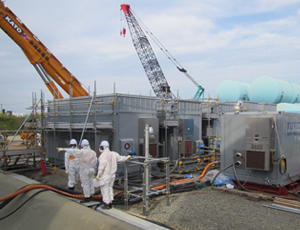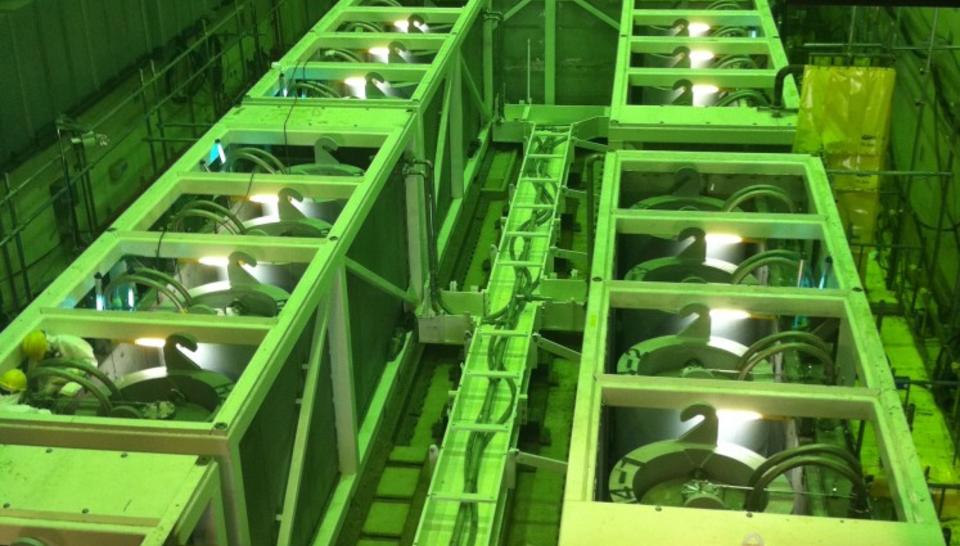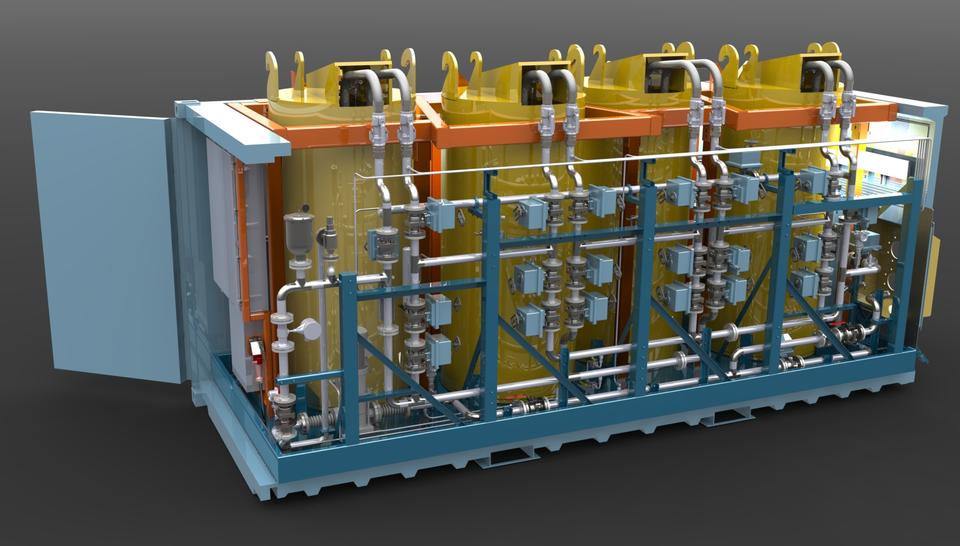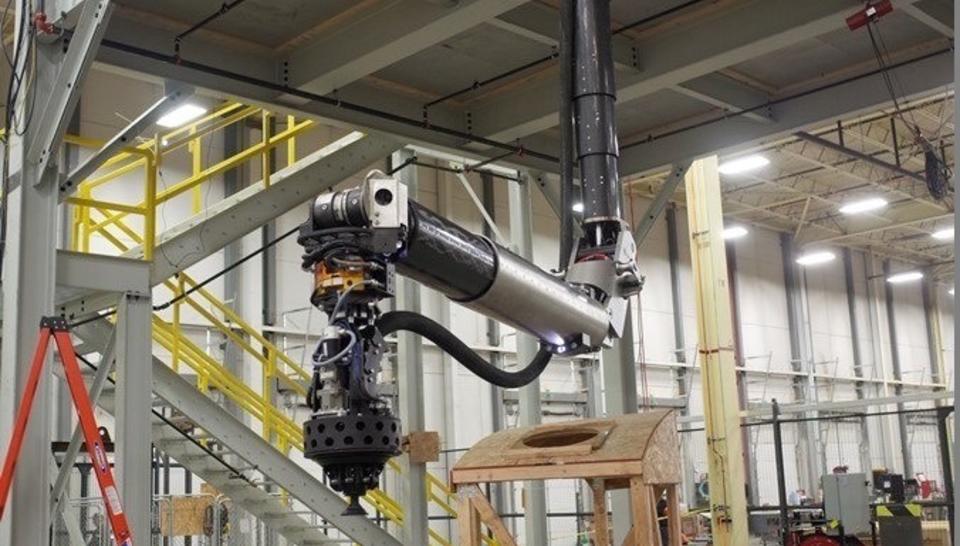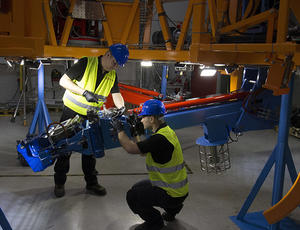To understand the path forward and the challenges that remain in the decades ahead, it is first critical to assess what has been achieved over the last ten years at the Fukushima site.
Through Kurion, the company was a first responder that provided support in the immediate aftermath of the earthquake and tsunami as part of efforts to recover control of the damaged reactors. The initial objective was to create an external reactor water cooling system to remove the need to pour cooling water on the molten reactor cores via helicopters and pumper trucks, and to avoid further build-up of very high-activity cesium-contaminated wastewater collecting inside building basements. This was to address concerns the water would overflow onto the site grounds, rendering much of the site a high-dose hazard zone and pollute local fishing grounds. On a non-stop, around-the-clock schedule, a 1,200 m3/day (317,000 gallons/day), first-of-a-kind external water-cooling system was designed, fabricated, delivered, and began operations in a mere eight weeks. The system featured the Veolia Ion Specific Media System (ISMS) to safely decontaminate the water.
Support the cleanup efforts
Within six months of its June 17, 2011 startup, the ISMS had removed more than 70% of the cesium and the plant was declared to be in a safe, secure, cold shutdown status. The ISMS was modified in 2015 to expand its decontamination capabilities, and continues to serve a mission-critical role today. To date it has processed 400,000 m3 of reactor cooling water (105 million gallons) and removed more than 10 million curies of cesium and strontium as well as many other isotopes.
In 2013, our Japanese partners turned to Veolia to design and construct a system to remove radioactive strontium from the large amount of cesium-depleted water stored in the roughly 800 tanks then at the Fukushima Daiichi site. The goal was to improve the safety of the site by reducing radioactive dose and the risk to the surrounding environment should tank leaks occur. Veolia designed, fabricated, and delivered a 300 m3/day (80,000 gallons/day) first-of-a-kind at-tank Mobile Processing System (KMPS) to decontaminate radioactive strontium from the water. Composed of five modified ISO shipping containers, an innovative flow sheet and ion exchange media, the patented KMPS employs a modular, plug-and-process design for rapid deployment.
Veolia’s first KMPS started operating at the Fukushima site in early October 2014 and removed more than 99.95% of the strontium from the water. Veolia was then asked to build a second system identical to the first, which was delivered in just 13 weeks. The two KMPS treated and decontaminated 50,000 m3 (13 million gallons) of strontium-contaminated storage tank water, helping achieve a major milestone to improve safety at the Fukushima site by March 31, 2015.
Veolia Nuclear Solutions’ support for the Fukushima cleanup effort has continued throughout the last decade. This includes performing studies and delivering solutions for treatment of cesium, strontium and contaminated sludge, robotic manipulators for inspection and repair of the damaged primary containment vessel, corium sampling and retrieval, sludge removal, and vitrification of legacy waste streams.
Throughout all of these efforts, Veolia Nuclear Solutions’ primary focus has been on supporting the Japanese authorities and our Japanese partners address the Fukushima recovery in the most safe, cost-effective and expeditious manner. Our experts from around the globe in France, the United Kingdom, Japan and the U.S. continue to collaborate with our Japanese partners, utilizing our collective experience to facilitate beneficial outcomes for the Fukushima project.
Looking Ahead
The progress made and solutions developed for the Fukushima site under the leadership of the Japanese authorities and Veolia’s Japanese partners have been crucial. The solutions and deployment of new technologies have, and will continue to be, transformational for the international nuclear community, providing valuable lessons and case studies to define best practices around the globe. And as is always the case within the nuclear industry, international cooperation has been a central ingredient to the progress made to date.
That is why Veolia Nuclear Solutions is undertaking a number of new initiatives to expand, deepen and improve our abilities in Japan and internationally to help our Japanese partners achieve the broad mission of decontamination and decommissioning at the Fukushima site. We will continue to deliver fit-for-purpose solutions to tackle some of the most difficult waste handling projects, while evaluating new technologies and treatment options such as vitrification to deliver the lowest life-cycle cost solutions for safe, reliable long-term waste disposition.
We are also taking steps to better harness the global resources, on-site expertise, and technological offerings of Veolia to bring added value to these projects. Primary among these steps is our commitment to making a significant investment in developing our footprint in Japan and transferring and sharing our technologies and knowledge with future Japanese partners.
In addition, Veolia Nuclear Solutions will continue to identify new ways to bring to bear our global expertise in decontamination and decommissioning from working with the CEA and EDF in France, the Department of Energy (DOE) in the U.S., and the Nuclear Decommissioning Authority (NDA) in the UK.
The close and supportive collaboration between Veolia Nuclear Solutions, our Japanese team at Kurion-Japan, and our trusted partners in Japan, is designed to benefit Japanese stakeholders in addressing this very challenging project. The last ten years have shown us the importance of perseverance and cooperation, and of working together in an open partnership to achieve this common goal of recovering the Fukushima site.
